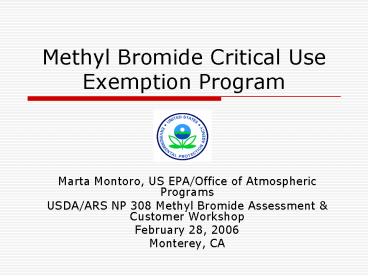Methyl Bromide Critical Use Exemption Program - PowerPoint PPT Presentation
Title:
Methyl Bromide Critical Use Exemption Program
Description:
Methyl Bromide Critical Use Exemption Program Marta Montoro, US EPA/Office of Atmospheric Programs USDA/ARS NP 308 Methyl Bromide Assessment & Customer Workshop – PowerPoint PPT presentation
Number of Views:112
Avg rating:3.0/5.0
Title: Methyl Bromide Critical Use Exemption Program
1
Methyl Bromide Critical Use Exemption Program
- Marta Montoro, US EPA/Office of Atmospheric
Programs - USDA/ARS NP 308 Methyl Bromide Assessment
Customer Workshop - February 28, 2006
- Monterey, CA
2
Overview of Presentation
- Methyl Bromide (MeBr) Critical Use Exemption
(CUE) Background - CUE Program Implementation
- CUE Regulatory Process
- Conclusions
3
Background CUE and MeBr Phaseout
- 1990 Clean Air Act (CAA) required MeBr phaseout
in 2001, no exemptions - U.S. pushed for schedule to match Montreal
Protocol (2005) - 1998 CAA Amendment aligned U.S., Protocol
- 25 in 1999
- 50 in 2001
- 75 in 2003
- 100 in 2005 (with allowable exemptions such as
CUEs, Quarantine Preshipment) - 2015 phaseout date for developing countries (some
countries have accelerated the phaseout)
4
Steps in Implementing CUE Process
- EPA solicits CUE applications from MeBr users
through a Federal Register notice - EPA conducts technical economic review of
applications - U.S. govt. develops Critical Use Nomination (CUN)
- State Dept. submits CUN to Ozone Secretariat
- Forwarded to Technology and Economic Assessment
Panel (TEAP) subsidiary body, Methyl Bromide
Technical Options Committee (MBTOC) - MBTOC reviews CUNs (2nd technical review, after
EPA), provides recommendations to Parties - Parties authorize exemptions in consensus-based
fashion - EPA conducts allocation Notice and Comment
Rulemaking
5
CUE Implementation Contd.
- All applications are carefully reviewed and
assessed by EPA experts - Technical analysis (pest pressure, effective
alternatives, etc.) - Economic analysis (yield losses, operating costs,
etc.) - The annual CUN is calculated on behalf of all
U.S. critical users - MBTOC now requires specific information on
certain sectors during their review process in
order to make recommendations
6
CUE Requests Granted
7
Regulatory Process
- EPA regulations typically require 12-18 months to
become effective - Sample Notice of Proposed Rulemaking (NPRM)
Process - EPA Inter-Office Work Group concurrence required
for significant actions - Inter-Agency agreement required for MeBr rules,
to ensure USDA, Dept. of State collaboration - Office of Management Budget (OMB) review--up to
90 days - Package routed for signature publication
- Public Comment period (30-60 days)
- Process repeated for Final Rules (except Public
Comment) - MeBr CUE regulations have all required expedited
scheduling
8
CUE Allocation
- Amount of overall total quantity allocation
authorized by EPA mirrors Decisions taken by
Parties - The Parties authorize most of the CUE from new
production, with the difference taken from
pre-phaseout existing inventory - Critical Use Allowances (CUAs)
- Critical Stock Allowances (CSAs)
- More flexible option (universal cap) preferred
during Allocation Framework NPRM comment period
(as opposed to sector-specific allocation) - Pre-plant cap (CUAs)
- Post-harvest cap (CUAs)
- CSAs are unrestricted
9
Regulatory Process contd.
ACTION AUTHORIZATION BY PARTIES DATE FINAL PUBLICATION
Allocation Framework/ 2005 CUEs 1st Ex-MOP Mar. 2004 Dec. 23, 2004
2005 Supplemental 16th MOP Nov. 2004 Dec. 13, 2005 (Direct Final pub. Aug. 30)
2006 CUEs 16th MOP Nov. 2004 2nd Ex-MOP July 2005 Feb. 6, 2006
2007 CUEs 17th MOP Dec. 2005 TBD (no delays expected)
10
Conclusions
- U.S. CUE process very successful thus far 90 of
all U.S. requests granted for 2005-07 calendar
years - Future CUE authorizations from the Parties will
continue to depend on robust nominations,
research, and transition plans for alternatives - EPA does not expect any delays in promulgating
the 2007 CUE rule because all authorizations were
granted 1 full year in advance - Thank you to USDA and CUE applicants for your
continued support and hard work!































